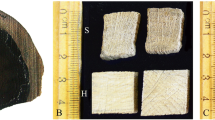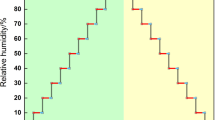Abstract
The potential of improving the hygroscopicity of solid wood by applying a new nanotechnology compound was investigated. The sorption isotherms were analysed using the Hailwood–Horrobin model. The experimental analysis of the sorption isotherms showed that the treatment affected total, polymolecular and monomolecular sorption. The application of the compound reduced the total sorption by 26.5%, polymolecular sorption by 23.9% and monomolecular sorption by 33.1% at saturation.



Similar content being viewed by others
References
Hager R, Mayer H (1994) Waterborne silicones for wood protection. In: paper presented at the 4th Asia pacific conference, May 1994
Hailwood A, Horrobin S (1946) Absorption of water by polymers: analysis in terms of a simple model. Trans Far Soc 42B:84–102
Hill CAS (2006) Wood modification—chemical, thermal and other processes. John Wiley, West Sussex, UK
Kaye GWC, Laby TH (1966) Tables of physical and chemical constants and some mathematical functions. Longmans, London
Kumar S (1994) Chemical modification of wood. Wood Fiber Sci 26(2):270–280
Mantanis GI, Papadopoulos AN (2009) Reducing the thickness swelling of wood based panels by applying a nanotechnology compound. Eur J Wood Prod. doi:10.1007/s00107-009-0401-6
Okoh KIA, Skaar C (1980) Moisture sorption isotherms of the wood and inner bark of the southern U.S. hardwoods. Wood Fiber Sci 12:98–111
Papadopoulos AN, Hill CAS (2003) The sorption of water vapour by anhydride modified softwood. Wood Sci Technol 37(3–4):221–231
Rowell RM (1983) Chemical modification of wood. For Prod Abstr 6(12):366–382
Siau JF (1984) Transport processes in wood. Springer, Berlin
Simpson W (1980) Sorption theories applied to wood. Wood Fiber 12(3):183–195
Spalt HA (1958) The fundamentals of water vapour sorption by wood. For Prod J 8(10):288–295
Stamm AJ (1964) Wood and cellulose science. Ronald Press, New York
Wangaard FF, Granados LA (1967) The effect of extractives on water-vapour sorption by wood. Wood Sci Technol 1:253–277
Wegner TH, Jones P (2006) Advancing cellulose-based nanotechnology. Cellulose 13:115–118
Wegner TH, Winandy JE, Ritter MA (2005) Nanotechnology opportunities in residential and non-residential construction. In: 2nd international symposium on nanotechnology in construction. Bilbao, Spain, pp 23–31
Acknowledgments
The authors wish to acknowledge Nanophos SA and Dr. Ioannis Arabatzis for their cooperation. The technical assistance of Mr. Ioannis Giannoulas of TEI Larissa is also acknowledged.
Author information
Authors and Affiliations
Corresponding author
Rights and permissions
About this article
Cite this article
Mantanis, G.I., Papadopoulos, A.N. The sorption of water vapour of wood treated with a nanotechnology compound. Wood Sci Technol 44, 515–522 (2010). https://doi.org/10.1007/s00226-010-0326-6
Received:
Published:
Issue Date:
DOI: https://doi.org/10.1007/s00226-010-0326-6




